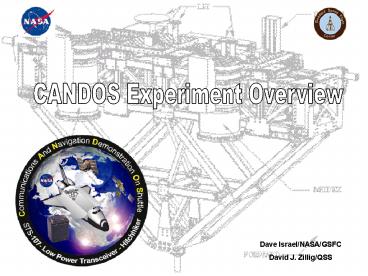CANDOS Experiment Overview - PowerPoint PPT Presentation
1 / 17
Title:
CANDOS Experiment Overview
Description:
Communications And Navigation Demonstration on Shuttle (CANDOS) TDRS-W (171/174 W) ... (Shuttle I/F) Orbiter Data Path. GPS Navigation. GEODE Software. On-board ... – PowerPoint PPT presentation
Number of Views:45
Avg rating:3.0/5.0
Title: CANDOS Experiment Overview
1
CANDOS Experiment Overview
Dave Israel/NASA/GSFC David J. Zillig/QSS
2
- The Communications and Navigation Demonstration
on Shuttle (CANDOS) will fly as an experiment on
the FREESTAR Hitchhiker payload on STS-107 - Low Power Transceiver
- The CANDOS Experiment will showcase the
integrated communications and navigation
functions of the Low Power Transceiver (LPT), a
modular, software programmable, multi-band,
multi-channel transceiver developed by NASA/GSFC
and ITT Industries under sponsorship of the NASA
Office of Space Flight - The LPTs capabilities include
- Space Network Communications/TDRSS
- Ground Network Communications/Ground stations
- GPS Navigation
- Mobile IP and IP-in-space applications
- Space-based Range Safety
- On-orbit reconfiguration
3
Communications And Navigation Demonstration on
Shuttle (CANDOS)
TDRS-W (171/174 W)
TDRS-E (41/46 W)
TDRS-Z (275W)
Global Positioning System (GPS) Constellation
GPS Navigation GEODE Software On-board
Navigation
S-Band LPT Com
S-Band LPT Com
S-Band LPT Com
- Space Network Communications
- TDRSS Data Relay Communications
- Mobile-IP in Space Demonstration via TDRSS
L-Band GPS Com
- Space-Based Range Safety
- Simultaneous TDRSS Ground Station
Communications
TDRS Space-to-Ground Links
S-Band LPT Com
- On-Orbit Reconfiguration
- Demonstrates ability to upgrade capabilities
- of Communications/Navigation Transceiver (LPT)
- while on-orbit
S-Band LPT Com
S-Band LPT Com
Dryden Flight Research Center (Range Safety Only)
IP Networks
CANDOS SN Data Path
CANDOS GN Data Path
HH Data Path
NASA/JSC (Shuttle I/F)
Orbiter Data Path
Wallops Island Ground Station
Merritt Island Ground Station
HitchHiker Control Center Goddard Space Flight
Center (GSFC)
White Sands Complex
- Ground Network Communications
- Direct-to-Ground Communications
- Mobil IP in Space Demonstration via Ground
Stations
4
CANDOS Experiments
GPS Navigation The LPT processes GPS signals
using the civilian C/A codes, performs code and
carrier phase measurements and maintains an
estimate of time. It also recovers and decodes
each tracked GPS spacecrafts ephemeris and
almanac broadcasts. In addition to
characterizing the LPTs GPS receiver, an
extended Kalman filter will be used to estimate
position and velocity (i.e., the state vector) of
the Shuttle, demonstrating the capability of a
spacecraft to determine its own state precisely
enough that it could navigate autonomously. On-or
bit Reconfiguration As a demonstration of the
ability to update the communications and
navigation functionality of future radiation
tolerant DSP and FPGA-based transceivers
on-orbit, a modified version of the LPTs DSP
firmware will be uploaded and commanded to
re-boot the experiment.
5
- IP-in-Space Mobile IP Experiment
- All communications between the GSFC Hitchhiker
control center and the CANDOS experiment on
STS-107 will use standard Internet Protocols
(IP). The protocols and applications to be used
and evaluated include - Multicast Dissemination Protocol (MDP) UDP
based, reliable file transfers from space - Network Time Protocol (NTP) UDP based
spacecraft clock synchronization - UDP packets - real-time spacecraft telemetry
- UDP packets spacecraft blind commanding
- Secure Shell (SSH) and Telnet TCP based remote
login to the spacecraft - Secure Copy (SCP) and FTP TCP based reliable
file transfer to and from the spacecraft - A highlight of the IP evaluations will be the
use of Mobile IP for automated route management
to the Shuttle. Mobile IP will autonomously
address IP packets, as required to route message
traffic between the LPT on the Shuttle and the
Hitchhiker control center in Maryland, regardless
of the ground station or TDRSS data relay
satellite through which they are communicating.
The changing communications paths as the Shuttle
orbits will provide an opportunity to evaluate
Mobile IP and assess its potential for use in
future space missions.
6
(No Transcript)
7
Space-Based Range Safety Experiment The CANDOS
Space-Based Range Safety Experiment will
demonstrate the use of the NASA/TDRSS as the
space-based platform to support the range safety
activities of the Eastern Range (ER), Western
Range (WR) as well as missile ranges, future
spaceports and other remote launch locations. A
single geosynchronous TDRSS spacecraft can
provide coverage from launch vehicle liftoff to
main engine cutoff, while the TDRSS constellation
can provide continuous coverage throughout
ascent, orbital operations, and landing. The
CANDOS experiment will demonstrate the LPT as a
fast-acquisition, multi-channel transceiver with
S-Band and L-Band frequency inputs to
simultaneously receive commands from a
launch-head ground station and from TDRSS and
position data from GPS and transmit the position
and range safety data back at S-Band through
TDRSS and the launch-head station.
8
SN Launch Range Coverage
Typical East Coast Launch Area
Typical West Coast Launch Area
West Coast TDRS Coverage Footprint(s)
East Coast TDRS Coverage Footprint(s)
9
CANDOS Flight Configuration
10
CANDOS Low Power Transceiver (Modified 1st Gen
LPT)
11
(No Transcript)
12
CANDOS SN GN Ground Station Configurations
13
CANDOS IP Station Network
14
GRID Channel Functional Block Diagram
Station Interfaces (RS-422 or TTL)
Router Interface (RS-530)
Prototype GRID (GLT) to be used for CANDOS
15
CANDOS Space Network Station Implementation
FWD RTN
FWD RTN
FWD RTN
- GRID Transmit Functions
- DCE Clock Source
- Scrambler
- Differential Encoder
- Convolutional Encoder
- GRID Receive Functions
- De-scrambler
Low Rate Data Switch 320x320 (WSC)
J8
GRID GLT
J9
MDM GSFC JSFC (WSC)
CANDOS Router
WSC/GSFC NISN Closed IO-NET (WSC)
16
CANDOS Ground Network Station Implementation
- GRID Transmit Functions
- Scrambler
- GRID Receive Functions
- De-scrambler
RF Uplink
NCPS
S-Band HPA
GRID GLT
RF Downlink
Wide Band S-Band Receiver
Bitsync
WPS/GSFC NISN Closed IO-NET (WPS)
CANDOS Router
17
Conclusions The CANDOS experiment will provide
the on-orbit demonstration of six payload
objectives TDRSS Communications, GN
Communications, GPS Navigation, On-Orbit
Reconfiguration, Space Based Range Safety, and
Mobile IP capabilities anticipated to be needed
to enable the next generation of space missions.
The first generation Low Power Transceiver (LPT)
to be flown on STS-107 will demonstrate a
flexible hardware and software platform to meet
those future needs.































